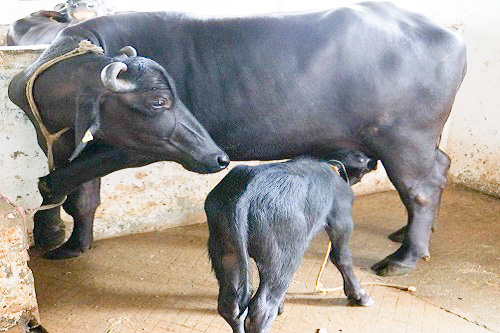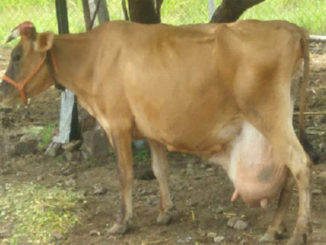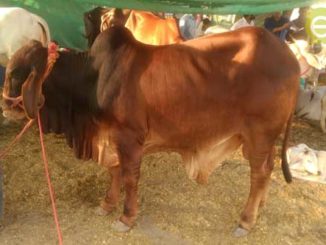Introduction
Reproductive success in dairy animals is a key to economic sustainability of livestock enterprise. A successful dairy management aims at achieving the goal of one calf per year for maximizing economic return from a farm. High reproductive efficiency in the dairy herd requires each dairy animals to calve during a pre-planned calving season, with a calving interval that maximises the economic output of milk production within the herd. Reproductive efficiency in the dairy animals has been decreasing in the past two decades, in parallel with high increases in milk production per animals. In dairy animals, nearly 10-30 per cent of lactations may be affected by infertility and reproductive disorders. Ideal level of days open (60-90 days), days dry (60 days) and calving interval (400 days) must be maintained. To attain good fertility or high calving rate both the male and female animals should be well fed and free from diseases.

Reasons for infertility
The causes of infertility are many and can be complex. Infertility or failure to conceive and give birth to a young one can be due to malnutrition, infections, congenital defects, management errors and ovulatory or hormonal imbalances in the female. Poor heat detection and AI not conducted at the right time of heat may also lead to infertility among animals.
Sexual cycle
Both cows and buffaloes have the sexual cycle (oestrus) once in 18-21 days for 18-24 hours. But in buffaloes, the cycle is silent posing a big problem to the farmers. The farmers should closely monitor the animals 4-5 times from early morning to late night. Poor heat deduction can cause increased levels of infertility. Considerable skill is needed to deduct the animals in heat for visible signs. Farmers who maintain good records and spend more time watching the animals obtain better results.
Management of Reproductive Efficiency
- Successful reproductive efficiency based on detection of oestrous, requires the need to accurately detect oestrous onset in the majority of dairy animals, and then inseminate 8 to 16 h later. This led to the common practice of breeding dairy animals according to the am-pm rule which requires that dairy animals are observed for oestrus five-times per day, those begin oestrus in the morning get inseminated that evening and those begin oestrus after 12.00 noon are inseminated the next morning (onset of oestrus defined as the first observation period where the cow/buffalo is observed to stand to be mounted by other herd mates or a teaser bull).
- Veterinarians managing fertility in dairy herds should regularly evaluate the herd health status for pathogens known to compromise reproductive efficiency. Infections with pathogens like Leptospira hardjo, bovine viral diarrhoea or herpes viruses are known to reduce conception rates, while infections with Neospora caninum and emerging viruses like the bluetongue virus may cause foetal losses and abortions. Therefore should be specifically monitored and controlled in herds suffering from uterine diseases, particularly where other risk factors are controlled or ruled out
- Deworming once in 6 months should be done for worm infestations to maintain the health status of the animals. A small investment in periodic deworming can bring greater gains in dairying.
- Provide suitable shelter management
- Cattle should be fed with a well balanced diet with energy, protein, minerals and vitamin supplements. This helps in increased conception rate, healthy pregnancy, safe parturition, low incidence of infections and a healthy calf.
- Care of young female calves with good nutrition helps them to attain puberty in time with an optimum body weight of 230-250 kgs, suitable for breeding and thereby better conception.
- Feeding adequate quantity of green fodder during pregnancy will avoid blindness in newborn calves and retention of placenta (after birth).
- In natural service, breeding history of the bull is very important to avoid congenital defects and infections.
- Infections of the uterus can be largely avoided by having cows calved under hygienic conditions and provided with proper bedding during calving.
- After 60-90 days of insemination, the animals should be checked for confirmed pregnancy by qualified veterinarians.
- Unwarranted stress and transportation should be avoided during the all stages of pregnancy.
- The pregnant animal should be housed away from the general herd for better feeding management and parturition care.
- Pregnant animals should be drained of their milk two months before delivery and given adequate nutrition and exercise. This helps in improving the health of the mother, delivery of a healthy calf with average birth weight, low incidence of diseases and early return of sexual cycle.
- Post partum breeding can be started within 2 months or 60 days after calving to achieve the goal of one calf per year for economic and profitable dairy farming, according to them.
Conclusion
Effective reproductive management requires that cows have a disease- and stress-free transition period; that cows resume normal oestrous cycles in the early postpartum period in association with high efficiency of detection of oestrus during the designated breeding season; and finally, that pregnancy rates per service are high and nutritional management of the cows is crucial to achieve the above targets. The prevention of metabolic and gynaecological disease is also important. Thus, high reproductive efficiency requires long-term planning, the implementation of good preventative measures to decrease periparturient diseases, and the interaction of herd managers, nutritionists and veterinarians in a coherent but coordinated fashion working together to achieve the above goals






Be the first to comment